SAS Bundle
How Did SAS Become a Global Analytics Powerhouse?
Journey back to the late 1960s, when a groundbreaking project at North Carolina State University sparked the creation of the SAS SWOT Analysis. This initiative, born from a need for advanced agricultural data analysis, would eventually give rise to one of the world's leading software companies. From its humble beginnings, SAS has transformed the landscape of data analysis and business intelligence.
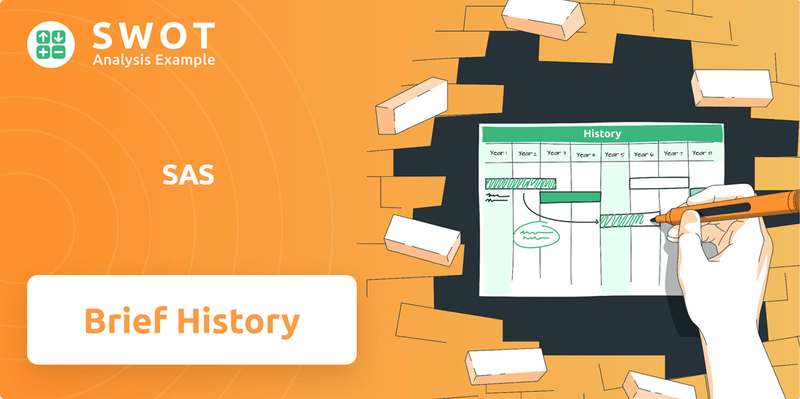
The SAS company, initially known as SAS Institute, was officially founded in July 1976, marking a significant milestone in the SAS history. With a vision to provide advanced business analytics, SAS software quickly gained traction, evolving from a statistical analysis software to a comprehensive suite of solutions. Today, SAS stands as a testament to innovation, impacting businesses globally and constantly pushing the boundaries of data-driven decision-making. The SAS company's origin story is a compelling example of how academic research can transform into a global business leader.
What is the SAS Founding Story?
The SAS company has a fascinating origin story, rooted in academia and driven by a need for better data analysis tools. The journey began in the mid-1960s at North Carolina State University, eventually evolving into a global leader in analytics. Understanding the SAS history provides key insights into its enduring success.
The SAS Institute's story is a testament to innovation and a commitment to its users. From its humble beginnings to its current status, the company has consistently adapted and expanded its offerings. This evolution is a key aspect of the SAS company origin story.
The roots of the SAS company trace back to 1966 at North Carolina State University. Anthony James Barr initiated a project to program SAS software for IBM System/360 computers to analyze agricultural data. James Goodnight joined in 1967, focusing on developing the software's statistical routines, and John Sall became part of the team in 1973.
- The project was initially funded by the National Institutes of Health, focusing on analyzing the impact of various factors on crop yields.
- By 1976, the SAS software had gained approximately 100 customers.
- The first SAS user conference in Kissimmee, Florida, drew 300 attendees.
- Recognizing the growing demand, Goodnight, Barr, Sall, and Jane Helwig founded SAS Institute Inc. on July 1, 1976.
Their first product was Base SAS software, comprising around 300,000 lines of code. Barr and Helwig later sold their interests in the company. The initial business model focused on leasing the software, primarily to agricultural departments. A unique aspect of their establishment was the immediate adoption of polling users for suggestions to improve the software through the 'SASware Ballot,' a tradition that continues today. Employee perks, such as fresh fruit and free M&M's, were also introduced in the first year, establishing a unique workplace culture. To learn more about the company's marketing strategies, you can read about the Marketing Strategy of SAS.
SAS SWOT Analysis
- Complete SWOT Breakdown
- Fully Customizable
- Editable in Excel & Word
- Professional Formatting
- Investor-Ready Format
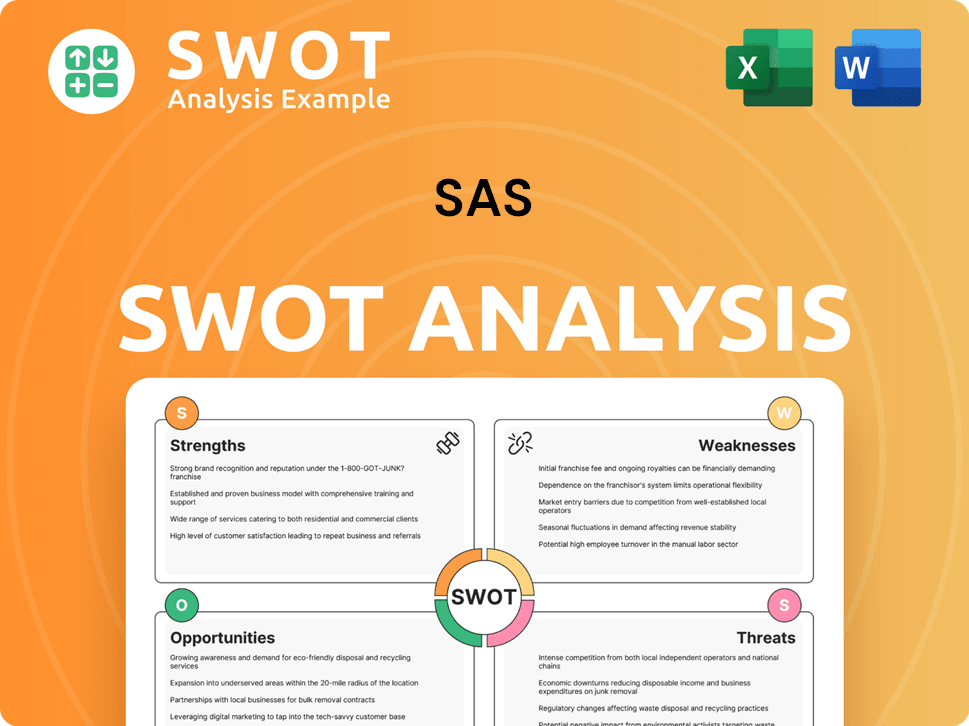
What Drove the Early Growth of SAS?
The early years of the SAS company were marked by rapid expansion and strategic development. This period saw the company grow significantly, broadening its product offerings and establishing a global presence. Key decisions and innovations during this time laid the groundwork for its future success in the analytics and business intelligence market.
By 1978, the SAS Institute had grown to 21 employees and served 600 customer sites. The 1980s were a pivotal decade, with the construction of its headquarters in Cary, North Carolina, beginning in 1980. This period also saw the company expanding its product line beyond basic data management and statistics.
Significant product milestones included the release of SAS software version 4 in 1984 and version 5 in 1986, which introduced a complete macro language and a full-screen interactive user interface. In 1985, the core software was rewritten in the C programming language to enhance portability. By 1989, the company had established a relationship with Microsoft and began development for Windows operating systems.
The company formed partnerships with major database companies like Oracle, Sybase, and Informix. From 1979 to 1985, the SAS company was recognized as one of Inc. Magazine's fastest-growing companies. Revenues grew from $10 million in 1980 to $1.1 billion by 2000. This demonstrates the strong financial trajectory of the company during this period.
The company prioritized employee welfare early on, opening an on-site childcare center in 1981 and expanding benefits and facilities by 1984. Global expansion began in 1985 with the opening of its first European subsidiary in the United Kingdom, leading to over 400 offices worldwide. If you want to know more about the SAS Institute's competitors, you can read about the Competitors Landscape of SAS.
SAS PESTLE Analysis
- Covers All 6 PESTLE Categories
- No Research Needed – Save Hours of Work
- Built by Experts, Trusted by Consultants
- Instant Download, Ready to Use
- 100% Editable, Fully Customizable
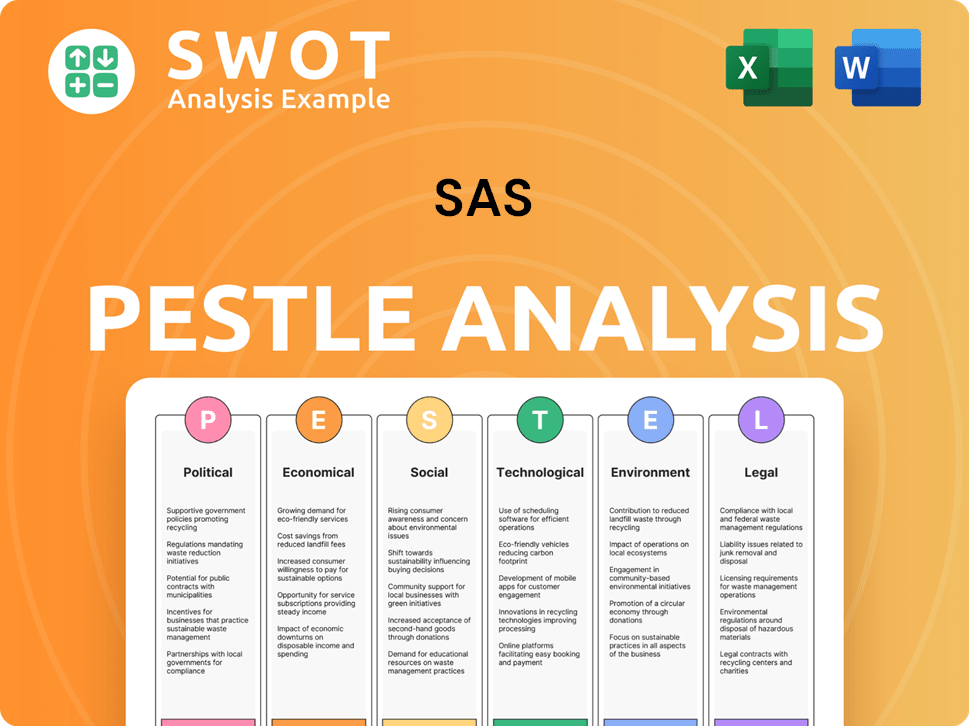
What are the key Milestones in SAS history?
The SAS company, a leader in analytics, has a rich history marked by significant milestones in the evolution of data analysis and business intelligence. From its inception, the company has consistently adapted to industry changes, driving innovation in the field of statistical analysis software.
| Year | Milestone |
|---|---|
| 1976 | SAS was founded by Jim Goodnight, John Sall, and others, initially developed as a statistical analysis system for agricultural research. |
| 1989 | JMP, a statistical software with a graphical user interface, was introduced, expanding SAS's offerings. |
| 2002 | SAS Text Miner was launched, enabling text data analysis for business intelligence. |
| 2004 | SAS Version 9.0 was released, making the software more accessible with custom user interfaces and SAS Enterprise Guide. |
| 2016 | SAS Viya, an AI and data management platform, was introduced with a cloud-optimized architecture. |
| 2019 | The company announced a $1 billion investment in AI R&D. |
| 2023 | SAS launched new AI development platforms, including SAS Viya Workbench and App Factory. |
| 2024 | SAS acquired Hazy, a synthetic data company, to enhance its generative AI portfolio. |
The company has been at the forefront of innovation, consistently investing a significant portion of its revenue in research and development. This commitment has led to the development of advanced analytics platforms and the integration of cutting-edge technologies.
In 1989, the introduction of JMP, a statistical software developed by co-founder John Sall, revolutionized data analysis. JMP leveraged the graphical user interface of the Apple Macintosh, making statistical analysis more accessible.
The launch of SAS Text Miner in 2002 enabled the analysis of text data for business intelligence. This innovation allowed businesses to extract valuable insights from unstructured data sources.
SAS Version 9.0, released in 2004, aimed to make the software more accessible to a broader range of business users. It introduced custom user interfaces and established SAS Enterprise Guide as the primary graphical user interface.
SAS Viya, launched in 2016, represented a significant leap forward with its AI, machine learning, analytics, and data management capabilities. It featured a new cloud-optimized architecture and enhanced interoperability with open-source software.
The company's commitment to AI is evident in its investments, including a $1 billion commitment in May 2023 for AI applications in banking, healthcare, and insurance over three years. This focus underscores the company's dedication to staying at the forefront of technological advancements.
The acquisition of Hazy in November 2024 enhances the company's generative AI portfolio. This strategic move helps customers overcome data access challenges and privacy barriers, facilitating the training and testing of AI models.
The company has faced challenges, including competition from open-source alternatives like Python and R, particularly among younger data scientists. To address these challenges, the company has been integrating with modern data platforms.
One of the primary challenges has been the rise of open-source alternatives like Python and R. These tools have gained popularity, especially among younger data scientists, posing a competitive threat to the company's market share.
To address competitive pressures, the company has focused on integrating its software with modern data platforms. This includes partnerships with companies like Microsoft, Snowflake, and Databricks, expanding its reach and appeal.
The acquisition of Hazy in 2024 addresses critical data access and privacy challenges. This acquisition allows the company to offer synthetic data solutions, enabling the training and testing of AI models without compromising sensitive information.
The company has launched new AI development platforms, such as SAS Viya Workbench and App Factory, to support the development of AI models and applications. These platforms are designed to streamline the AI development process.
The introduction of Viya Copilot, a generative AI assistant, further supports developers and data scientists. This tool enhances productivity and efficiency in the development and analysis of data-driven solutions.
The company consistently invests a high percentage of its revenue in research and development, typically spending between 20-30% annually. This sustained investment underscores its commitment to innovation and staying ahead of market trends.
SAS Business Model Canvas
- Complete 9-Block Business Model Canvas
- Effortlessly Communicate Your Business Strategy
- Investor-Ready BMC Format
- 100% Editable and Customizable
- Clear and Structured Layout
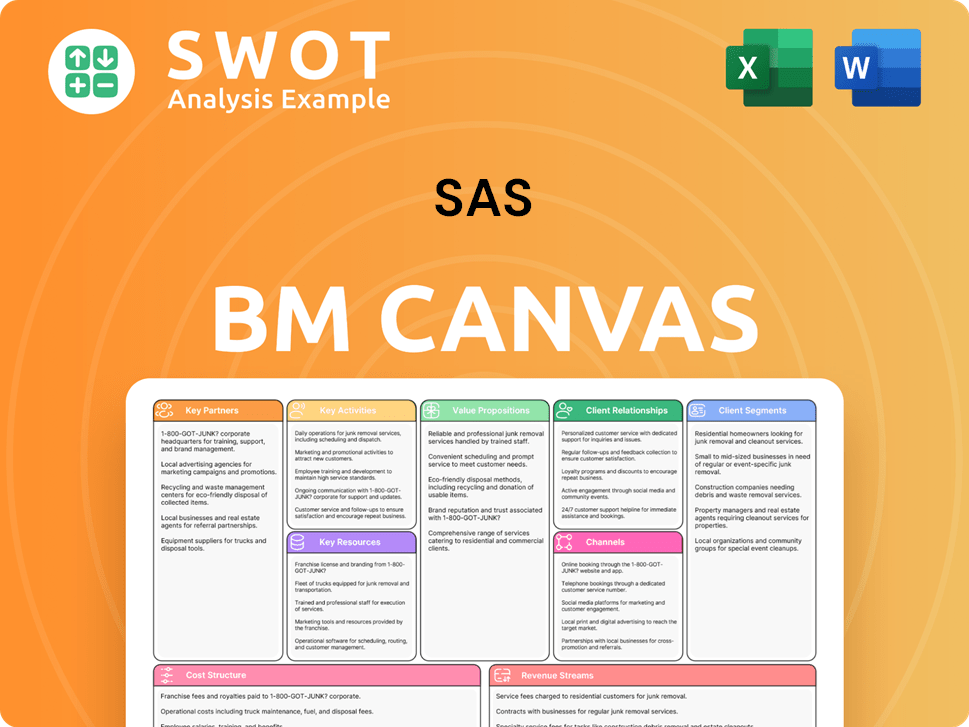
What is the Timeline of Key Events for SAS?
The SAS company, a leader in analytics, has a rich SAS history, marked by significant milestones. From its inception as a project at North Carolina State University to its current status as a global enterprise, the company has consistently evolved to meet the changing needs of data analysis and business intelligence. The SAS Institute has played a pivotal role in the advancement of SAS software and statistical analysis software.
| Year | Key Event |
|---|---|
| 1966 | The Statistical Analysis System project began at North Carolina State University, laying the foundation for the future. |
| 1971 | Beta release of the Statistical Analysis System (SAS 71) marked a significant step in the development of the software. |
| July 1, 1976 | SAS Institute Inc. was incorporated as a private company, formalizing its structure. |
| 1976 | Base SAS software was released, representing the company's first commercial product. |
| 1980 | SAS began building its current headquarters in Cary, North Carolina. |
| 1981 | SAS opened its first on-site childcare center, reflecting its employee-centric values. |
| 1985 | The first European subsidiary opened in the United Kingdom, signaling global expansion. |
| 1989 | JMP statistical software was shipped for the first time, expanding its product offerings. |
| 1989 | The company began its relationship with Microsoft and development for Windows operating systems. |
| 2002 | SAS Text Miner software was introduced, enhancing its text analytics capabilities. |
| 2004 | SAS Version 9.0, 'Project Mercury,' was released, improving accessibility. |
| 2016 | SAS Viya, an AI, machine learning, analytics, and data management platform, was introduced. |
| 2019 | SAS announced a $1 billion investment in AI R&D, emphasizing its commitment to innovation. |
| July 2021 | SAS announced preparations for an initial public offering (IPO). |
| May 2023 | SAS announced an additional $1 billion investment in AI applications for banking, healthcare, and insurance over the next three years. |
| 2024 | SAS launched SAS Data Maker and developed 12 prepackaged AI models. |
| November 2024 | SAS acquired Hazy, a synthetic data company. |
SAS is strategically focused on continued innovation in AI and cloud solutions, aiming to be the enterprise-grade data and AI platform of choice. The company's updated growth strategy centers on the Viya cloud platform. SAS is working to encourage customers to migrate to it.
Viya as a service, with consumption-based pricing via major hyperscalers (Microsoft Azure, AWS, and Google Cloud Platform), is targeted for 2026. This could significantly impact its market position and adoption rates. In 2025, SAS plans to introduce 11 additional prepackaged AI models.
SAS has been preparing for an IPO, with initial targets of 2024, now shifting to 2025 as the company standardizes its contracts and implements new financial and accounting systems. This move is intended to offer new opportunities for employees, customers, and partners.
SAS continues to record more than $3 billion in annual sales and is financially strong with no debt, allowing it the patience to wait for the right market conditions for an IPO. The company's future outlook is tied to its commitment to being a trustworthy data and AI partner.
SAS Porter's Five Forces Analysis
- Covers All 5 Competitive Forces in Detail
- Structured for Consultants, Students, and Founders
- 100% Editable in Microsoft Word & Excel
- Instant Digital Download – Use Immediately
- Compatible with Mac & PC – Fully Unlocked
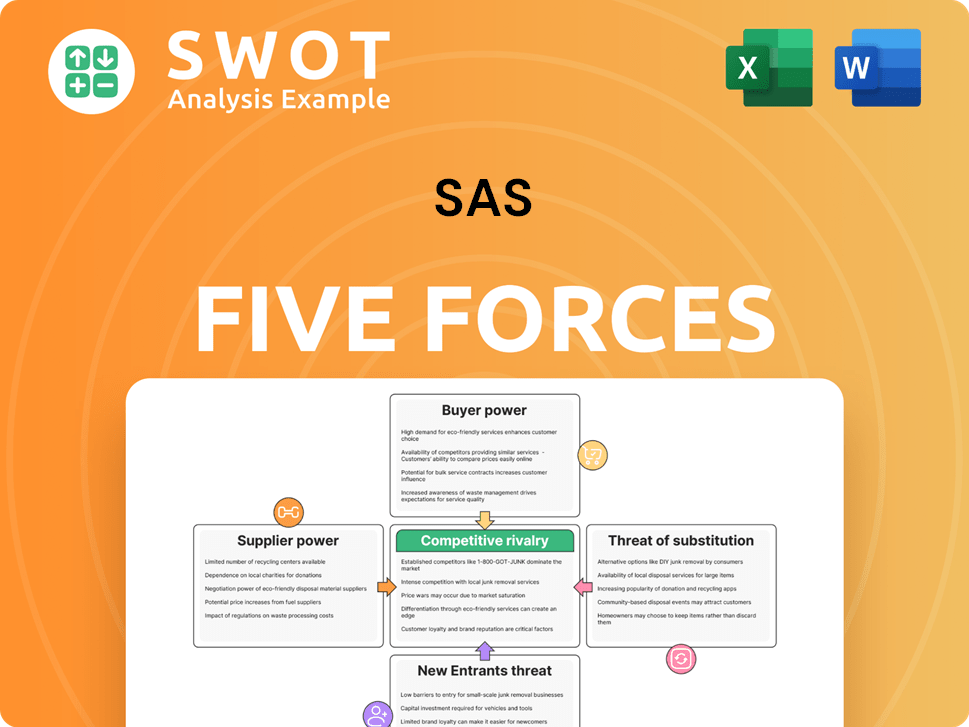
Related Blogs
- What is Competitive Landscape of SAS Company?
- What is Growth Strategy and Future Prospects of SAS Company?
- How Does SAS Company Work?
- What is Sales and Marketing Strategy of SAS Company?
- What is Brief History of SAS Company?
- Who Owns SAS Company?
- What is Customer Demographics and Target Market of SAS Company?
Disclaimer
All information, articles, and product details provided on this website are for general informational and educational purposes only. We do not claim any ownership over, nor do we intend to infringe upon, any trademarks, copyrights, logos, brand names, or other intellectual property mentioned or depicted on this site. Such intellectual property remains the property of its respective owners, and any references here are made solely for identification or informational purposes, without implying any affiliation, endorsement, or partnership.
We make no representations or warranties, express or implied, regarding the accuracy, completeness, or suitability of any content or products presented. Nothing on this website should be construed as legal, tax, investment, financial, medical, or other professional advice. In addition, no part of this site—including articles or product references—constitutes a solicitation, recommendation, endorsement, advertisement, or offer to buy or sell any securities, franchises, or other financial instruments, particularly in jurisdictions where such activity would be unlawful.
All content is of a general nature and may not address the specific circumstances of any individual or entity. It is not a substitute for professional advice or services. Any actions you take based on the information provided here are strictly at your own risk. You accept full responsibility for any decisions or outcomes arising from your use of this website and agree to release us from any liability in connection with your use of, or reliance upon, the content or products found herein.